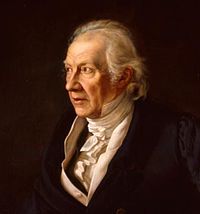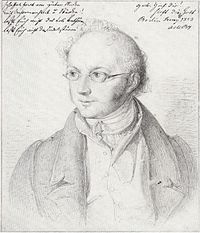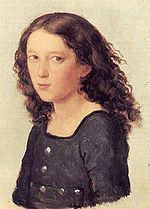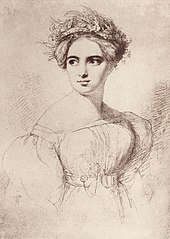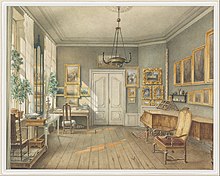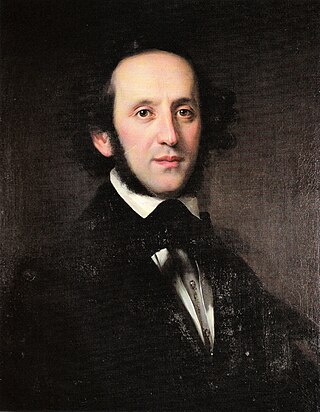
Jakob Ludwig Felix Mendelssohn Bartholdy, widely known as Felix Mendelssohn, was a German composer, pianist, organist and conductor of the early Romantic period. Mendelssohn's compositions include symphonies, concertos, piano music, organ music and chamber music. His best-known works include the overture and incidental music for A Midsummer Night's Dream, the Italian Symphony, the Scottish Symphony, the oratorio St. Paul, the oratorio Elijah, the overture The Hebrides, the mature Violin Concerto, the String Octet, and the melody used in the Christmas carol "Hark! The Herald Angels Sing". Mendelssohn's Songs Without Words are his most famous solo piano compositions.

Carl Friedrich Zelter was a German composer, conductor and teacher of music. Working in his father's bricklaying business, Zelter attained mastership in that profession, and was a musical autodidact.
Many of the thirteen children of Daniel Itzig and Miriam Wulff, and their descendants and spouses, had significant impact on both Jewish and German social and cultural history. Notable ones are set out below.

Abraham Ernst Mendelssohn Bartholdy was a German Jewish banker and philanthropist. He was the father of Fanny Mendelssohn, Felix Mendelssohn, Rebecka Mendelssohn, and Paul Mendelssohn.
Songs Without Words is a series of short lyrical piano works by the Romantic composer Felix Mendelssohn written between 1829 and 1845. His sister, Fanny Mendelssohn, and other composers also wrote pieces in the same genre.

Paul Hugo Wilhelm Hensel was a German philosopher.
Wolfram Lorenzen was a German pianist.
Felix Mendelssohn wrote four pieces for string quartet that were published together as his “Opus 81” after his death. They have at times wrongly been presented as a single work, even as his “String Quartet No. 7”:

The Piano Trio No. 2 in C minor, Op. 66, was written by Felix Mendelssohn in 1845 and published in February 1846. The work is scored for a standard piano trio consisting of violin, cello and piano. Mendelssohn dedicated the work to his close friend and violinist, Louis Spohr, who played through the piece with the composer at least once.
Felix Mendelssohn's Piano Quartet No. 2 in F minor, Op. 2, for piano, violin, viola and cello was published in 1823, a year after his first Piano Quartet No. 1 in C minor, Op. 1. This work was dedicated to Carl Friedrich Zelter, who became Mendelssohn's composition and music tutor starting at the age of eight years old. Zelter would take Mendelssohn on trips to go see Johann Wolfgang von Goethe, who was also an important figure in Mendelssohn's life when it came to the composition of his earliest pieces between the years 1821-1825. Mendelssohn's three piano quartets were the first piano quartets he composed and published. He composed the second quartet at the age of only 14 years.

The Mendelssohn family are the descendants of Mendel of Dessau. The German Jewish philosopher Moses Mendelssohn and his brother Saul were the first to adopt the surname Mendelssohn. The family includes his grandchildren, the composers Fanny Mendelssohn and Felix.

Emilie Luise Friderica Mayer was a German composer of Romantic music. Although Emilie Mayer began her serious compositional study relatively late in life, she was a very prolific composer, eventually producing some 8 symphonies and at least 15 concert overtures, as well as numerous chamber works and lieder. She is often referred to as the "Female Beethoven" because of her pioneering attitude and similarities in style.
Franz Seraphin Lauska, baptised as Franciscus Ignatius Joannes Nepomucensis Carolus Boromaeus, was a Moravian pianist, composer, and teacher of Giacomo Meyerbeer. The name "Seraphin" was a later name affix, which Lauska never used. Lauska was considered "one of the most brilliant executants of his time."
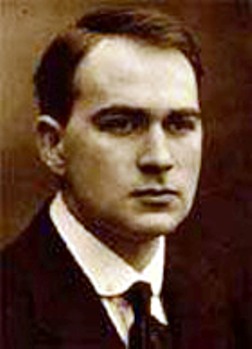
Sándor Jemnitz, also known as Alexander Jemnitz, was a Hungarian composer, conductor, music critic and author.

The Piano Trio in D minor, Op. 11, by Fanny Mendelssohn was conceived between 1846 and 1847 as a birthday present for her sister, and posthumously published in 1850, three years after the composer's death.
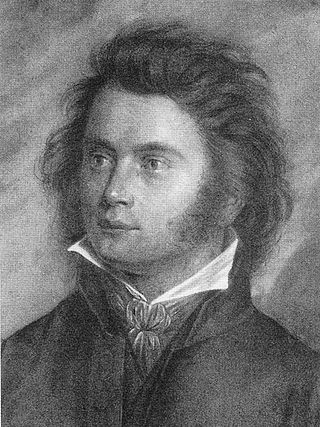
Friedrich Theodor Fröhlich was a Swiss early Romantic composer.

Sechs Lieder, Op. 59, is a collection of six part songs for four voices a cappella by Felix Mendelssohn. He composed the songs between 1837 and 1843, setting six poems in German. They are subtitled "Im Freien zu singen", and focus on nature. They were published after his death as part of his complete works. One of the songs, "O Täler weit, o Höhen" became so popular that it is also regarded as Volkslied.

Lea Mendelssohn Bartholdy was a musician, musical promoter, and salonièrre. She was the wife of banker and cultural patron Abraham Mendelssohn Bartholdy and mother of the composer Fanny Hensel, the composer Felix Mendelssohn, the singer and salonnière Rebeckah Mendelssohn Dirichlet and the banker and cellist Paul Mendelssohn Bartholdy. A promoter of music and culture, she was the centre of a musical salon in Berlin, which had developed since 1819 from the domestic musical life of the Mendelssohn family and gained considerable importance from 1831 onwards through the activities of her daughter Fanny.

Sara Levy, born Sara Itzig was a German harpsichordist, patron of the arts and music collector. Her salon was the meeting place of the most important musicians and scholars in Berlin, and she was also known as a philanthropist.

Joanne Polk is a pianist with Bachelor of Music and Master of Music Degrees from The Juilliard School, and a Doctor of Musical Arts Degree from the Manhattan School of Music. She holds master classes at many universities and festivals across the country and in Asia.

